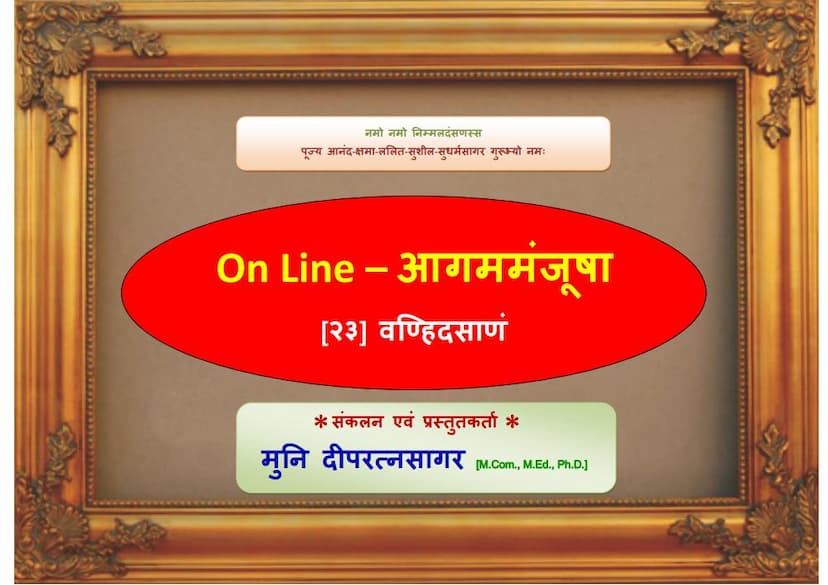Aagam Manjusha 23 Uvangsuttam Mool 12 Vahnidasaa
Added to library: September 1, 2025

Summary
Here's a comprehensive summary of the provided Jain text, "Aagam Manjusha 23 Uvangsuttam Mool 12 Vahnidasaa":
Introduction and Context:
The document is an online presentation of the Jain Agam text, "Vahnidasaa," which is part of the Upanga Sutras (specifically, the 23rd text in the Agam Manjusha series). The online version is presented by Muni Deepratnasagar, building upon the work of the original editor, Acharya Shri Anand Sagar Suriji M.S. The original Agam Manjusha was compiled 70 years prior (in 1942 CE/VS 1998/VS 2468). This online edition, released in 2012 CE/VS 2068/VS 2538, aims to provide wider access through the internet, with some minor modifications to the original compilation. These modifications include the inclusion of commentary (Niyukti, Bhashya) alongside original verses in certain texts, the inclusion of an alternative text (Pindniyukti for Oghniyukti), and the inclusion of the Kalpa (Barasa) Sutra.
Content of "Vahnidasaa" (Pages 3-5):
The core of the provided text presents narrative accounts, likely illustrating the teachings and lives of significant figures within Jainism. The key narratives revolve around:
-
Prince Nishath (Nisadha) and his Spiritual Journey:
- The text describes the city of Dwarka and its prominent figures, including Krishna Vasudeva and Baladeva.
- Prince Nishath is introduced, and his upbringing, including the dream of seeing a lion, is detailed.
- Lord Ariṣṭanemi (Arishtanemi), the 22nd Tirthankara, arrives in Dwarka and delivers a sermon.
- Prince Nishath, after hearing the sermon, becomes deeply devoted to Lord Ariṣṭanemi and his teachings.
- He renounces his worldly life, becomes an ascetic (anagar), and diligently practices austerities, eventually attaining the eleventh Anga of Jain scriptures.
- His spiritual discipline includes practices like Chaturth (fasting for four days), Shashtam (fasting for six days), Ashtam (fasting for eight days), and various other severe penances and austerities for nine years.
- After his passing, he is reborn in the Brahmaloka heaven and then destined to become a Tirthankara himself in the Mahavideha region. The text details his lifespan in heaven and his future rebirth.
-
Prince Virangata and his Spiritual Journey:
- The narrative shifts to the city of Rohidaka, where King Mahabala and Queen Padmavati reign.
- Prince Virangata is born and undergoes a similar spiritual awakening after hearing the teachings of Acharya Siddhartha.
- He renounces his kingdom and becomes an ascetic.
- He practices various austerities, including fasting and other penances, for forty-four years.
- Upon his death, he is reborn in the Brahma realm for ten Sagaropama years.
- After his heavenly lifespan, he is reborn as the son of King Baladeva and Queen Revati in Dwarka, becoming Prince Nishath. This highlights the interconnectedness of karmas and rebirths.
-
Prince Nishath's Understanding and Devotion:
- The text emphasizes Prince Nishath's deep understanding of life and soul (Jiva-Ajiva).
- He is described as being in a state of contemplation and meditation.
- He reflects on the blessedness of those who follow Lord Ariṣṭanemi.
- He expresses his desire to see and pay homage to Lord Ariṣṭanemi.
- Upon encountering Lord Ariṣṭanemi again, he takes initiation and dedicates himself to spiritual practice.
- The text details his further austerities, including fasting for forty-two days, and his eventual attainment of liberation (Moksha) in the Uchchatar region of the heavens.
-
The Role of Acharya Varadatta:
- Acharya Varadatta, an ascetic and disciple of Lord Ariṣṭanemi, plays a crucial role in explaining the past lives and spiritual journeys of Prince Nishath and Prince Virangata. He clarifies the karmic causes behind their experiences and their future destinies to Prince Nishath.
Concluding Remarks and Textual Information:
- The text concludes by stating that the "Vahnidasaa" chapter is the fifth section (varga) of the fourth group of Upangas.
- It mentions that there are eleven chapters in total for this section, with the initial eleven chapters being presented.
- It notes that the "Nirayavaliya Sutra" is completed and that all Upanga Sutras are concluded.
- It also provides information about the inscription of these scriptures on stone in a Jain temple, dating back to VS 2468.
Overall Theme:
The "Vahnidasaa" text, as presented, appears to be a narrative that illustrates the principles of karma, rebirth, renunciation, spiritual discipline (tapasya), and the ultimate attainment of liberation (Moksha) within Jainism. It highlights the importance of devotion to Tirthankaras and the profound impact of one's actions across lifetimes. The stories of Prince Nishath and Prince Virangata serve as examples of individuals who overcome worldly attachments through spiritual pursuits.